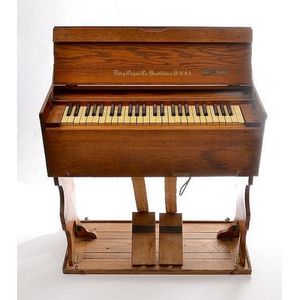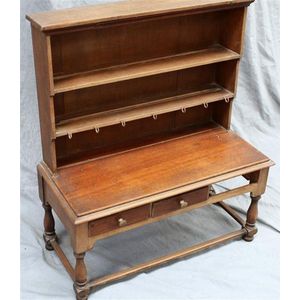German Oak Serving Table with Marble Top and Drawers
19th century German oak three tier serving table, of rectangular form with hinged top opening to reveal white marble insert and adjustable shelf, set with two carved frieze drawers, above two lower shelves on four turned and fluted supports, 87 x 115 x 45 cm
You must be a subscriber, and be logged in to view price and dealer details.
Subscribe Now to view actual auction price for this item
When you subscribe, you have the option of setting the currency in which to display prices to $Au, $US, $NZ or Stg.
This item has been sold, and the description, image and price are for reference purposes only.
- Tier - One or more under-shelves of a table or cabinet.
- Frieze - An architectural term denoting the flat, shaped or convex horizontal surface of furniture, between the architrave and the cornice, usually found on a cabinet or bookcase, or on desks and tables where it may include drawers, the area between the top and the legs. In ceramics, the term refers to the banding, of usually a repeating pattern, on the rims of plates and vases.
- Oak - Native to Europe and England, oak has been used for joinery, furniture and building since the beginning of the medieval civilisation. It is a pale yellow in colour when freshly cut and darkens with age to a mid brown colour.
Oak as a furniture timber was superceded by walnut in the 17th century, and in the 18th century by mahogany,
Semi-fossilised bog oak is black in colour, and is found in peat bogs where the trees have fallen and been preserved from decay by the bog. It is used for jewellery and small carved trinkets.
Pollard oak is taken from an oak that has been regularly pollarded, that is the upper branches have been removed at the top of the trunk, result that new branches would appear, and over time the top would become ball-like. . When harvested and sawn, the timber displays a continuous surface of knotty circles. The timber was scarce and expensive and was used in more expensive pieces of furniture in the Regency and Victorian periods. - Fluting - A form of decoration found on many pieces of furniture, as well as ceramics, silver and clocks, in which round-bottomed grooves, of varying width and depth, are let into columns, pilasters, legs. As a general rule, flutes are cut in the vertical, though they may follow a turned leg in a spiral pattern. In cross-section, they may be described as a series of 'U' shapes, rising and narrowing at each end of the groove. Fluting is the opposite of reeding, with which fluting is often associated.
- Turning - Any part of a piece of furniture that has been turned and shaped with chisels on a lathe. Turned sections include legs, columns, feet, finials, pedestals, stretchers, spindles etc. There have been many varieties and fashions over the centuries: baluster, melon, barley-sugar, bobbin, cotton-reel, rope-twist, and so on. Split turning implies a turned section that has been cut in half lengthwise and applied to a cabinet front as a false decorative support.
This item has been included into following indexes:
Visually similar items

Vintage nest of tables, with inlaid top to largest table, 52 cm wide, 56 cm high
Sold by
in
for
You can display prices in $Au, $US, $NZ or Stg.

Organ, early 20th century portable peddle church organ by 'Estey Organ Co.
Sold by
in
for
You can display prices in $Au, $US, $NZ or Stg.

Antique French Henri II walnut marble topped sideboard, 167 cm high, 124 cm wide
Sold by
in
for
You can display prices in $Au, $US, $NZ or Stg.

A 19th century miniature oak kitchen dresser. Height 65 cm, width 55 cm, depth 25 cm
Sold by
in
for
You can display prices in $Au, $US, $NZ or Stg.
